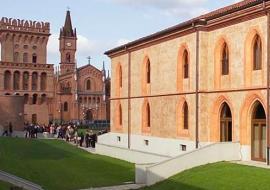This is the Grand Italian Wine by definition, also produced entirely with Nebbiolo grapes. Barolo wine comes from the village in the Langa bearing the same name a few kilometres south of Alba. It is now made in eleven ‘communes’ or village territories, all situated on the scenic Langa hills shaped by centuries of vine cultivation and dominated by medieval castles – including Barolo’s own. The other communes included in the Barolo production area are: La Morra, Monforte, Serralunga d’Alba (with its exceptionally well- preserved medieval military fortress), Castiglion Falletto (its symbol, a round medieval tower, belongs to a still privately-owned manor building), Novello, Grinzane Cavour, Verduno, Diano d’Alba, Cherasco and Roddi (here the castle is currently being restored).
These communes, unlike Barolo, are only permitted to cultivate Nebbiolo for Barolo on a part of their territory. Thanks to the farming genius of Count Camillo Benso of Cavour (who was also Italy’s first Prime Minister) and to the intuition of Giulia Colbert Falletti, the last Marquess of Barolo, Barolo wine began to be produced around halfway through the 19th century. This wine, particularly rich and harmonious, became the Savoy Family’s best ambassador, representing Piedmont in all the royal courts of Europe.
Together with Barbaresco, Barolo saw the rise of many associations in its favour during the course of 20th century, starting with ‘Pro-Barolo’ and culminating in the foundation of the Consortium and the attribution of Doc and then Docg status and, finally, in 2005, the Control Plan for Certification required by the European Union. One of the last and most important pieces of research on Barolo, has been the collection of the ‘cru list’ or Additional Geographical Definitions and its inclusion in the Disciplinary regulations in 2009. The same type of list had already been compiled for Barbaresco a couple of years earlier.
The idea behind this list is not to judge the excellence of each cru but rather to provide the wine world with a means to understand the names of localities mentioned on wine labels. Obviously, major problems and various territorial disputes had to be overcome in order to arrive at the definitive version and the list will certainly be of vital importance as a guide for future generations. To understand Barolo’s importance is to appreciate its complexity. The bouquet is full and enveloping and capable of developing over time without losing any of its organoleptic characteristics.
These captivating qualities led the nobility of the 19th century to give it the title ‘King of wines and wine of kings’. The colour is a full and intense garnet red and the perfumes are both fruity and spicy. Red berries, cherries in liqueur and jam are present both in the nose and in the mouth, together with roses, faded violets, cinnamon, pepper, nutmeg, vanilla and, at times, liquorice, cocoa, tobacco and leather. Barolo must be allow to age for at least three years, one and a half of which has to be in oak barrels. If the ageing is prolonged for five years, the wine gains the title of ‘Reserve’.
As for Barbaresco, there are traditional and more international versions, according to taste – the more modern techniques include the use of small oak barrels. At the moment, the tendency is a return to roots, with sobriety dominating production methods. What small differences there are do make for a stimulating range of experiences however, all of the highest level. This is a wine that is pleasing to the palate after four to five years and at its maximum after around ten but that can also be consumed with enormous pleasure after twenty or more. Obviously, the quality of the vintage plays its part: some are perfect and the resulting wine a masterpiece. Others, like the notorious 1977 vintage, produced no Barolo at all, while, 2002 with its summer of rain and hail, required all the skill of expert enologists to produce a valid wine.
For the tourist who desires to taste Barolo in its home country there are many possible holiday solutions. The ‘Strada del Barolo’ route includes many local producers, and there are also many local wine shops (Botteghe Comunali) with much choice and information, including those in: Serralunga, Diano d’Alba, Castiglion Falletto, the cooperative winery of La Morra, the Enoteca Wine shop of Grinzane Cavour (with a wonderful view over the entire region) and the Enoteca wine Shop of Barolo, where a fascinating and comprehensive Wine Museum is being prepared. Other points of interest, including many private enterprises, can be found throughout the area and there are also many private wineries who are more than happy to welcome tourists into their cellars.

| << | April 2024 | >> | ||||
| Sun | Mon | Tue | Wed | Thu | Fri | Sat |
| 1 | 2 | 3 | 4 | 5 | 6 | |
| 7 | 8 | 9 | 10 | 11 | 12 | 13 |
| 14 | 15 | 16 | 17 | 18 | 19 | 20 |
| 21 | 22 | 23 | 24 | 25 | 26 | 27 |
| 28 | 29 | 30 | ||||